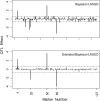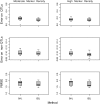Extended Bayesian LASSO for multiple quantitative trait loci mapping and unobserved phenotype prediction
- PMID: 20805559
- PMCID: PMC2975286
- DOI: 10.1534/genetics.110.119586
Extended Bayesian LASSO for multiple quantitative trait loci mapping and unobserved phenotype prediction
Abstract
The Bayesian LASSO (BL) has been pointed out to be an effective approach to sparse model representation and successfully applied to quantitative trait loci (QTL) mapping and genomic breeding value (GBV) estimation using genome-wide dense sets of markers. However, the BL relies on a single parameter known as the regularization parameter to simultaneously control the overall model sparsity and the shrinkage of individual covariate effects. This may be idealistic when dealing with a large number of predictors whose effect sizes may differ by orders of magnitude. Here we propose the extended Bayesian LASSO (EBL) for QTL mapping and unobserved phenotype prediction, which introduces an additional level to the hierarchical specification of the BL to explicitly separate out these two model features. Compared to the adaptiveness of the BL, the EBL is "doubly adaptive" and thus, more robust to tuning. In simulations, the EBL outperformed the BL in regard to the accuracy of both effect size estimates and phenotypic value predictions, with comparable computational time. Moreover, the EBL proved to be less sensitive to tuning than the related Bayesian adaptive LASSO (BAL), which introduces locus-specific regularization parameters as well, but involves no mechanism for distinguishing between model sparsity and parameter shrinkage. Consequently, the EBL seems to point to a new direction for QTL mapping, phenotype prediction, and GBV estimation.
Figures






Similar articles
-
A decision rule for quantitative trait locus detection under the extended Bayesian LASSO model.Genetics. 2012 Dec;192(4):1483-91. doi: 10.1534/genetics.111.130278. Epub 2012 Sep 14. Genetics. 2012. PMID: 22982577 Free PMC article.
-
Overview of LASSO-related penalized regression methods for quantitative trait mapping and genomic selection.Theor Appl Genet. 2012 Aug;125(3):419-35. doi: 10.1007/s00122-012-1892-9. Epub 2012 May 24. Theor Appl Genet. 2012. PMID: 22622521 Review.
-
The effect of different approaches to determining the regularization parameter of bayesian LASSO on the accuracy of genomic prediction.Mamm Genome. 2025 Mar;36(1):331-345. doi: 10.1007/s00335-024-10088-7. Epub 2024 Dec 11. Mamm Genome. 2025. PMID: 39661159
-
Iteratively reweighted LASSO for mapping multiple quantitative trait loci.Brief Bioinform. 2014 Jan;15(1):20-9. doi: 10.1093/bib/bbs062. Epub 2012 Sep 28. Brief Bioinform. 2014. PMID: 23023740
-
Advances in Bayesian multiple quantitative trait loci mapping in experimental crosses.Heredity (Edinb). 2008 Mar;100(3):240-52. doi: 10.1038/sj.hdy.6801074. Epub 2007 Nov 7. Heredity (Edinb). 2008. PMID: 17987056 Free PMC article. Review.
Cited by
-
Identification of grouped rare and common variants via penalized logistic regression.Genet Epidemiol. 2013 Sep;37(6):592-602. doi: 10.1002/gepi.21746. Epub 2013 Jul 8. Genet Epidemiol. 2013. PMID: 23836590 Free PMC article.
-
Statistical analysis of genetic interactions.Genet Res (Camb). 2010 Dec;92(5-6):443-59. doi: 10.1017/S0016672310000595. Genet Res (Camb). 2010. PMID: 21429274 Free PMC article. Review.
-
A simulation-based breeding design that uses whole-genome prediction in tomato.Sci Rep. 2016 Jan 20;6:19454. doi: 10.1038/srep19454. Sci Rep. 2016. PMID: 26787426 Free PMC article.
-
Priors in whole-genome regression: the bayesian alphabet returns.Genetics. 2013 Jul;194(3):573-96. doi: 10.1534/genetics.113.151753. Epub 2013 May 1. Genetics. 2013. PMID: 23636739 Free PMC article.
-
Composite Interval Mapping Based on Lattice Design for Error Control May Increase Power of Quantitative Trait Locus Detection.PLoS One. 2015 Jun 15;10(6):e0130125. doi: 10.1371/journal.pone.0130125. eCollection 2015. PLoS One. 2015. PMID: 26076140 Free PMC article.
References
-
- Gilks, W.R., S. Richardson and D. J. Spiegelhalter, 1996. Markov Chain Monte Carlo in Practice. Chapman & Hall, London.
-
- Hoerl, A. E., and R. W. Kennard, 1970. Ridge regression: biased estimation for nonorthogonal problems. Technometrics 12 55–67.
Publication types
MeSH terms
Substances
LinkOut - more resources
Full Text Sources

